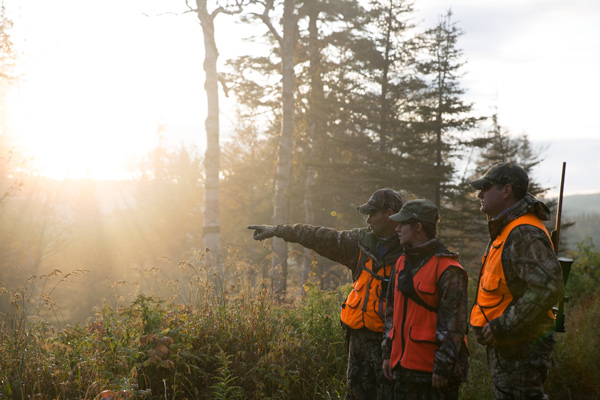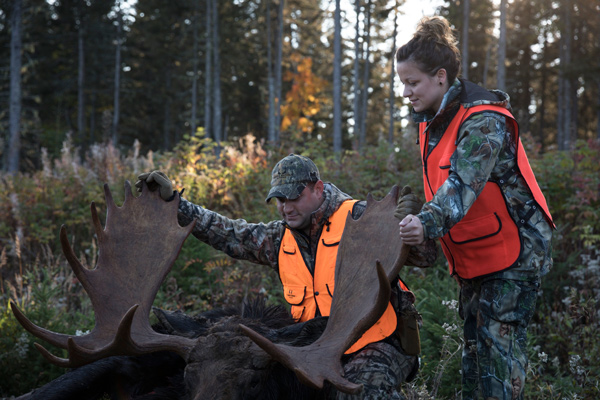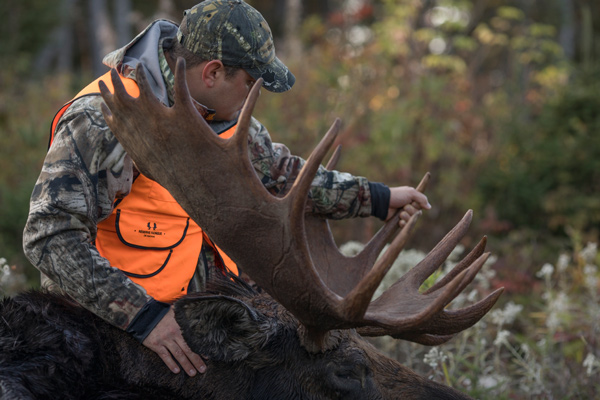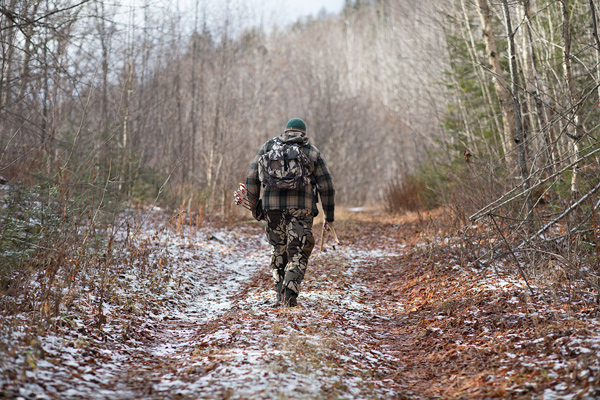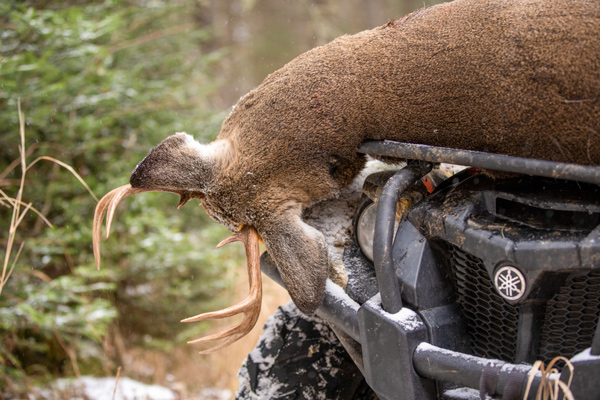From gunshot to freezer
How to store your game meat properly
The big moment has finally arrived! Once you've taken the necessary steps, you can set out to find the big game that you've been dreaming about for so long.
You've been preparing for ages! All the gear is ready, the licence is purchased, your firearm has been fine-tuned, and you've even scoured the maps of your hunter’s playground for the best prospects. Many hunters will also have taken the time to head into the heart of their allotted territory to set up salt licks, install spy cameras, and develop olfactory subterfuge. You want everything to be perfect and to put all the odds on your side, as the saying goes.
The big day
After taking the necessary precautions, you head to your site and wait patiently for a large cervid to come your way. Suddenly, a magnificent beast appears within range. You exhale, hold your breath, concentrate, and take aim. Your trophy collapses to the ground. You jump for joy. You’ve finally harvested one of these large mammals with such tender and delicious flesh. You must now bring the body back home, taking care to preserve the precious venison in the best possible way.
The story of a pro: the hunter's butcher
Not far from Valleyfield, in Saint-Stanislas-de-Kostka, there’s a butcher shop that transforms various wild meats into delectable artisanal products. In the 1970s, Gérard Himbeault offered his services as a butcher. In 1977, his son Raymond and his wife Liliane took over. Having experienced great success with hunting enthusiasts, they decided, in 1986, to process only products harvested by these devotees. Daniel, the third generation of this line of aficionados, joined the team in 1999 and became the owner of Himbeault Gibier in 2015, thus ensuring the succession.
Each year, our clients entrust this team with over 2,500 deer and 400 moose, along with thousands of waterfowl, hundreds of wild turkeys, bears, and many other types of game.
To get the most out of your meat – equivalent to 55% of the total weight of a quartered moose (with the skin, but without the legs and head) or about 50% of a whole deer without the viscera – there are several precautions to take. Here's Daniel Himbeault's expert advice on how to store your game meat properly.
Safety first
When approaching your seemingly lifeless capture, you must remain vigilant. Even when mortally wounded, a beast can inflict serious injuries with its hooves or horns before giving up the ghost. To ensure that your prey is dead, take a long enough branch and try to touch the pupil of one of its eyes. If the moose or deer does not respond, you can be sure that its heart has stopped beating.
What to do… asap
Under ideal conditions, to obtain quality meat, the body mass should be chilled as soon as possible, preferably within 12 hours of death.
As soon as these ruminants succumb, their digestive system begins to ferment, which considerably slows down the drying of the carcass. Therefore, the viscera should be removed as soon as possible, ideally within two hours of death depending on the size of the game animal and the outside temperature, to keep the venison from overheating. Remember that when handling the blade, extra care must be taken to avoid piercing the digestive tract or bladder, which could result in some contamination of the meat. If this happens inadvertently, clean the affected meat with a cloth soaked in potable water.
Misconception
The cost of processing your trophy is charged by weight upon arrival at the butcher shop. Many people think they’re saving money by removing the skin from the cervid before handing it over to the specialist, but this natural shield allows the meat to mature without drying out too much. If we take the case of a large deer for example, its coat can weigh up to 5 kg. However, without this protection, the surface meat will dry out and you may have to cut off 10 to 14 kg of meat.
Winged enemies
Many hunters believe that covering a deer or moose carcass with traditional cheesecloth is enough to protect the venison from flies looking to lay their eggs. Before using cheesecloth, however, Daniel Himbeault reminds us that these flying creatures must be scared off: if they’re trapped under the cloth, they’ll cause even more damage. The ideal solution is to lightly smudge the exposed areas before covering them. You can also sprinkle pepper liberally, directly on the flesh, before inserting spruce or cedar branches under the cheesecloth to create a gap between the blood, meat, and protective material.
Moose
If you harvest one of these kings of the forest, cut the carcass into quarters and hang them up to accelerate cooling. Avoid immersing the various edible parts in a lake or river, as this could contaminate the meat. You should also trim and remove any bruised, damaged, or abnormal-looking parts of the carcass.
If you cannot lift them, try to create air circulation under the pieces of meat by placing them on logs on a rock or at the bottom of a rowboat, with the skin facing upwards. A wooden pallet can be very useful for this task and for transport.
The Ministère de l'Agriculture, des Pêcheries et de l'Alimentation du Québec (MAPAQ) strongly recommends that you cool the game carcass to 7°C within 24 hours before your return trip; otherwise the temperature may still be too high and may promote the growth of bacteria.
Deer
To maximize tenderness, the hunter's butcher advises hanging the deer by its hind legs so that the buttocks are well apart. After evisceration, don't forget to remove the anus. You should also avoid perforating or tearing the intestines to prevent contamination of the meat.
Practices to avoid
As soon as you remove the giblets, wash them with clean water and wrap them in cheesecloth. Place them on a cooler bag or a bottle of frozen water. Do not make the mistake of putting offal (heart, liver, etc.) in a closed plastic bag while it is still warm: any airtight packaging will prevent cooling. Do not put offal directly on the ice either for contact with water is not recommended.
Maturation
After a deer is harvested, it will be aged to allow the muscle fibers to loosen. Aging is best done before the animal is skinned to avoid drying out the entire body surface or quarters, and to minimize waste.
A ripening time of one week is suggested for juveniles. For adults, depending on their age and size, the butcher recommends waiting 10 to 21 days to allow the venison to tenderize to the maximum. Keep in mind, however, that this period may be shorter if the specimen has not been stored in conditions deemed satisfactory.
Normally, the longer the maturation period, the more likely the meat will have a strong gamey taste.
Steak, corn, potato
"It's always surprising to see hunters placing their meat orders as if there were nothing else but steaks, roasts, cubes, and ground meat," explains Daniel Himbeault. However, his team also prepares flank steaks, squares, osso buco, ribs, cutlets, Chinese fondue, confit, various types of cold cuts (including pepperoni and salami), smoked meat, 22 types of sausages in small and large sizes, and more. You can even order festive products for times of celebration such as the Christmas holidays, including tourtières (traditional meat pies), appetizers, terrines, cretons, rillettes, pies, and much more.
In the freezer
At Himbeault Gibier, all cuts are vacuum-packed. This process significantly increases the shelf life of the meat, extending it up to three years. Once the cuts are well frozen, you simply have to keep the packages from knocking together so that they don’t crack.
When you have the urge to eat a primed piece, you can easily thaw it by putting it under running water.
Few people know that you can thaw a quality vacuum pack in the refrigerator and then put it back in the freezer afterwards if the contents have not been consumed. Since it has not been in contact with air or other products, there’s no impact other than the fact that the venison continues to mature when not frozen. However, Daniel does not recommend doing this repeatedly.
Recycle
Sometimes hunters inadvertently forget to rotate the contents of their freezers and discover older packages of meat in there. To avoid waste, Himbeault Gibier can re-process these cuts of venison into sausages, jerky, sausages, terrines, smoked meat, and other delights.
Chow time…
The cooking method is the final touch to ensure the tenderness of the venison. It's important to take your time and get the right information for the cuts you want to prepare and present. For a steak, for example, Daniel Himbeault prefers slow cooking. He turns the meat over only once, so as to obtain optimal cooking on each side.
Good hunting and enjoy your tasty harvest!

